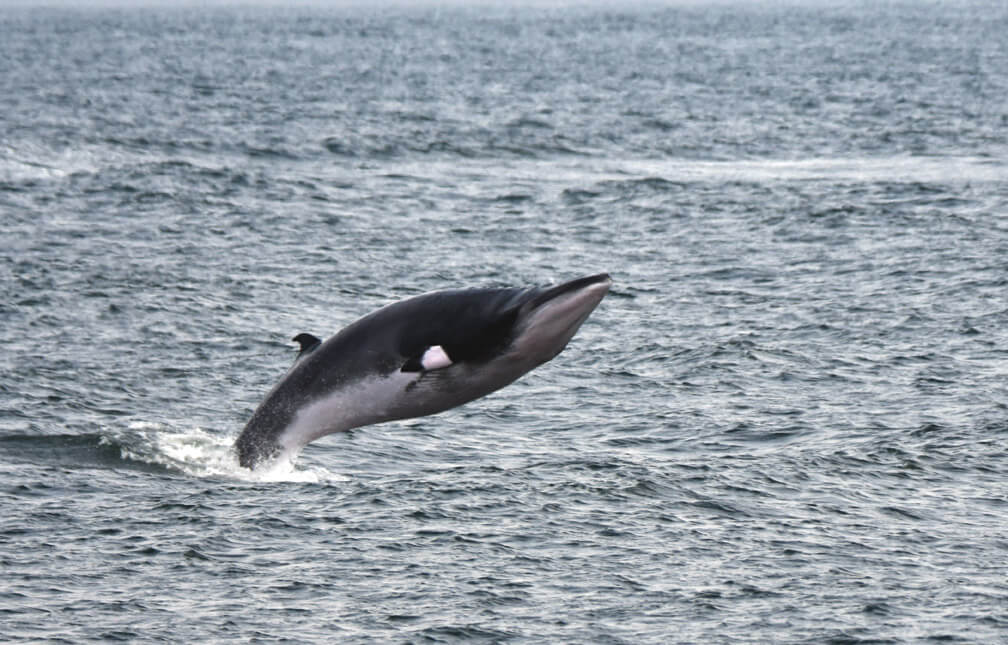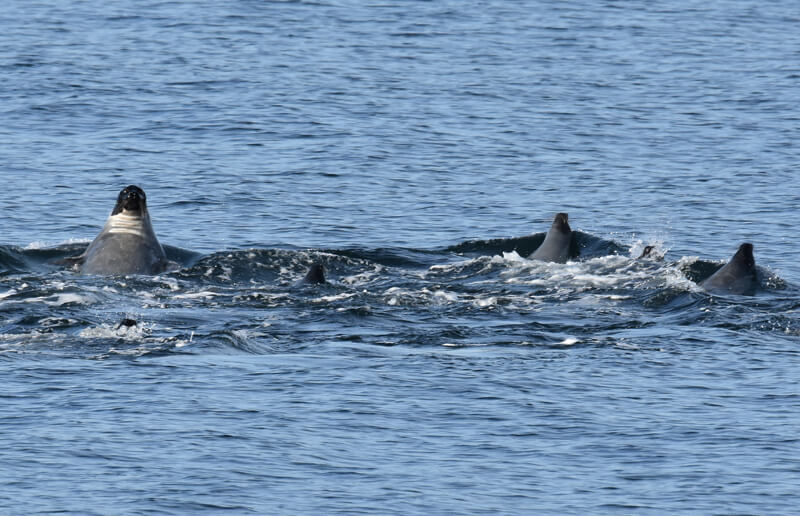Minke and humpback whales are soaring in the air these days, while other members of their species bustle about at the surface. The whales are gorging themselves on small fish before winter sets in. A quick overview of the latest observation highlights.
Saguenay-Saint-Laurent Marine Park, on- and offshore
Dress warmly if you want to see whales! “I’m wearing all my clothes on me right now, plus heat pads in my boots,” reports bird surveyor Jessé Roy-Drainville on November 18. Posted atop the Tadoussac dunes, he scans the sea in search of whales during lulls in the bird migration. While he’s been seeing minke whales actively foraging at the surface every day, his sightings of large whales are growing increasingly rare. “On Sunday, however, I saw four humpbacks. Between Île Verte and the dunes, there were also three fin whales.”
A final whale-watching cruise departs Tadoussac in pursuit of these animals on November 15. On board, Renaud Pintiaux recognizes H918, H944 and H859 (in French), as well as an unidentified humpback. He also spots seven fin whales and a number of belugas and minke whales. “I was especially impressed by the herds of harp seals. There was one that must have numbered at least 100 individuals!” These seasonal visitors have a unique behaviour compared to other pinnipeds: they often swim on their backs (article in French). This position might help them see better what’s happening below, whether it is potential prey or a lurking predator!
From the rocks of Les Bergeronnes or Les Escoumins, those brave enough to face the cold are rewarded with a few passing minke whales or belugas or the appearance of the occasional head of a seal poking above the water. On November 12, through his binoculars, one lucky observer even catches a breaching humpback offshore!
On November 15, a woman on holiday at a chalet in Essipit observes two minke whales swimming in tandem. “Is this a prelude to reproduction?” she wonders. That would be surprising, as in the St. Lawrence Estuary, most minkes are females, to the point that 100% of the biopsies ever taken from this species belonged to females. Even the adult carcasses that turn up are all those of females. So why swim at exactly the same speed and in synchrony? That’s anyone’s guess!
From the Gaspé shores
In Newport, a woman out for a stroll enjoys a leisurely swimming minke whale for almost an hour on November 11. Was it searching for prey in the area? In any case, its behaviour contrasts with that of other minke whales near Cap-des-Rosiers. “There are currently nearly a dozen minke whales about two nautical miles from shore. No, I stand corrected, there must be at least twenty! They’re popping up everywhere along with harbour porpoises!” says one observer.
«D’habitude, je fais moitié randonnée, moitié observation, mais aujourd’hui, mon chien n’a pas marché beaucoup tellement il y avait d’observations à faire!», s’exclame une randonneuse au Cap Bon-Ami, dans le parc national Forillon. Le 11 novembre, aux jumelles, elle alterne entre la nage rapide des petits rorquals près de la rive et les plongées impressionnantes des rorquals à bosse plus au large. Des claquements sonores l’interpellent: cinq ou six phoques gris grognent et frappent leurs pattes à la surface. Des marsouins communs apparaissent un peu plus loin. Quatre espèces en même temps! Hélas, le parc ferme sa barrière, la randonneuse doit rentrer. Elle jette un dernier œil au large avant de partir: un petit rorqual saute dans les airs. «Quel cadeau de fin de saison!»
“Usually, I like to combine hiking and whale-watching, but today, my dog didn’t get much exercise because there were too many whales to observe!” exclaims a hiker at Cap Bon-Ami in Forillon National Park. On November 11, through her binoculars, she switched back and forth between swift minke whales near the coastline and the impressive dives of humpbacks farther offshore. Suddenly a certain commotion catches her attention: five or six grey seals are growling and slapping their paws on the surface. Harbour porpoises appear a little farther away. Four species at the same time! Alas, the park closes its gate, and the hiker has little choice but to return home. Before leaving, she takes one last glance out to sea, where she catches sight of a breaching a minke whale. “What a gift to mark the end of the season!”
On November 15, opposite Gros-Morne, a motorist pulls over to the side of the road. “I spotted a humpback emerge with its mouth wide open! Just like in the video of the kayakers you posted last week. A municipal vehicle then pulled up behind me. I thought he was going to tell me I wasn’t allowed to park there, but no, he wanted to watch the whale feed, too!”
Humpback whales have developed all sorts of foraging strategies. Depending on where you are on the planet, certain populations and sometimes even certain individuals will use their own techniques. For example, in the North Pacific, researchers have documented humpbacks treading motionless at the surface and dragging their enormous pectoral fins toward their heads, steering the fish into their mouths. Others combine the bubble net technique – creating a spiral of bubbles to force the fish to form tighter, denser schools – with movements of their fins to coax the fish into their mouths.
In Petit-Cap, minke and humpback whales are also plying the waters on November 15. Once again, the whales are hugging the pebbly coastline. “They were in such little water that the humpbacks weren’t even lifting their tails when they dove,” points out one observer. Are these whales using the shallow depth to their advantage to generate super-sized bites? It’s possible. For whales, feeding requires a lot of energy. Each gulp must therefore be “profitable” in terms of calorie intake vs. energy expenditure!
Off the coast of Sept-Îles
From shore, between Port-Cartier and Sept-Îles, one can sometimes catch a glimpse of a seal’s head or a passing minke whale. But on November 13, Mingan Island Cetacean Study collaborator Jacques Gélineau went out to sea, where he crossed paths with one blue whale, two fin whales, a humpback and a few stealthy minke whales and harbour porpoises. “There are a lot fewer animals than there were last month, which is to be expected. Most of them must have started their migration already, but the stragglers are still feeding.”






